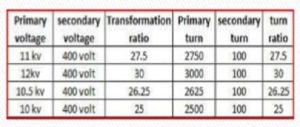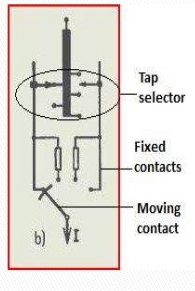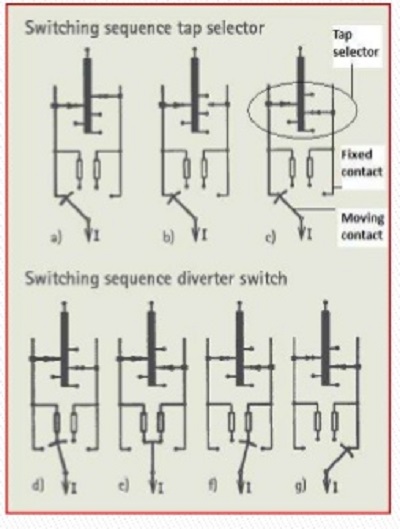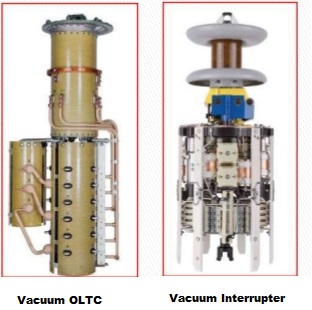A tap changer is a device fitted to power transformers for regulation of the output voltage to required levels. On-load tap-changers (OLTCs) are indispensable in regulating power transformers used in electrical energy networks and industrial applications. OLTC changer alters the turn ratios of the transformer on the system by altering the number of turns in one winding of the appropriate transformer. Tap changers offer variable control to keep the supply voltage within these limits.
Typically tap changers are of two types:
- Off load or No Load Tap Changers NLTC
- On load Tap Changer OLTC
However since the offload tap changer causes interruption in the supply on load tap changers are more preferred in in today power system. In larger electrical power transformer, for proper voltage regulation of transformer, on load tap changer is required. Various types of On Load & Off Load Tap changers are offered to suit the number of taps, current rating, step voltage and number of poles. On load tap changers are resistor transition equipment’s which are used to vary the ratio of oil immersed transformers under load. In general they are designed for network transformers as well as industrial transformer applications.
The tap changers are designed to give reliable service under the most arduous conditions which occur on electrical power systems. Tap changers are designed such that power flow can be handled in either direction at full rated current. The tapping arrangement, is placed in separate divertor tank attached to electrical power transformer main tank. Inside this tank, the tap selectors are generally arranged in a circular form. The divertor switches have contacts operating in rapid sequence with usually four separate make and break units. When the tap changer has several tappings it is advantageous to halve the length of tapping winding and to introduce a reversing over changeover selector.
By the transformation ratio
V1/V2= N1/N2
V2=N2/N1×V1
From the above equation by altering the turn ratio to suitable values the secondary voltage can be adjusted desired level.
Lets – N1=2750, N2=100, turn ratio= N1/N2=2750/100=27.5
why we choose this turn ratio – V1=11 KV, V2= 400Volt
Transformation ratio V1/V2= 11000/400=27.5
Each tap corresponds to different transformation ratio. For Initial installation we need to choose a suitable tap as per our voltage levels. Tap changers provides 5 to 20 % voltage range for voltage regulation.
An on load tap changer has 3 major steps:
a. Tap selector- it selects the appropriate tap
b. Fixed contact- These contacts hold a fixed position
c. Moving contact- This contact moves to open/ close the appropriate taps.
Switching Sequence of Tap Selector & Diverter Switch
Based on the AVR feedback the suitable tap is selected fig (a) to (c). After the tap is selected the moving contact moves and it closes both taps for a while. It moves further and finally completely opens to earlier tap and closes to the next tap fig (d) to (i).

The moving contact closes two taps for a while during the tap changing, due to which a circulating current starts to flow. This current needs to be minimized. For limiting this current resistor or reactors are used. The moving contact is operated by charged spring tension and it completes the process within 30 to 70ms. The spring is charged by motor drives. While opening and closing the contacts sparks are produced due to arising recovery voltage. The contacts are kept in oil or SF6 gas , which work as insulation medium as well as arc quenching.
Components & Construction of Tap Changer
Motor drive unit (MDU): This unit has got a motor diver and other necessary controls. Motor charges the spring to rapidly perform the switching. Power is transferred via shaft & gear mechanism.
Diverter switch /Oil compartment: This has the diverter switch, which has moving and fixed contacts. It is filled with oil or SF6 gas to avoid the sparking & quenching during opening and closing of the contacts.
Tap selector: It has different tap combinations as specified by the customer requirements and different standards.

Due to opening closing of contacts the sparks produce and the oil degrades over the time. The oil test & analysis needs to be done in lab at regular interval. The contacts wear over the time after number of operations. The oil seals damage over the time and leakage happens. Maintaining the oil level is must. For condition monitoring its must to check for oil leak and level regularly. Oil dripping is dangerous for environment as well. OLTC includes a lot of gear, spring and mechanical parts which have a usual wear and tear, that need to be taken care as an when required.
Vacuum type OLTC uses the vacuum interrupters which has some advantages over oil / SF6. It is hermetically sealed and has no interaction with surrounding medium despite the arc. Contacts wear is lower than OIL/SF6. No aging or quenching medium is required. Its more environment friendly. Vacuum interrupters perform up to 600000 operation without replacement. Has low maintenance cost and greater reliability.

Dual Voltage Transformers
A dual voltage transformer can be defined as the one which is capable of providing two types of voltage. A dual voltage transformer has two windings in primary and two other windings in secondary. By connecting the both windings either of primary or secondary in series or parallel two different voltages are produced.
From the figure two primary windings and two secondary windings are connected in series resulting in 240 volt input and 24 volt out put voltage. From the second figure you can see that the primary and secondary windings are connected in parallel, resulting 120 volt input and 12 volt out put voltage. There can be either type of arrangements as per requirement.

Video On Function & Principle of OLTC
Discover more from Electrical Engineering 123
Subscribe to get the latest posts to your email.

